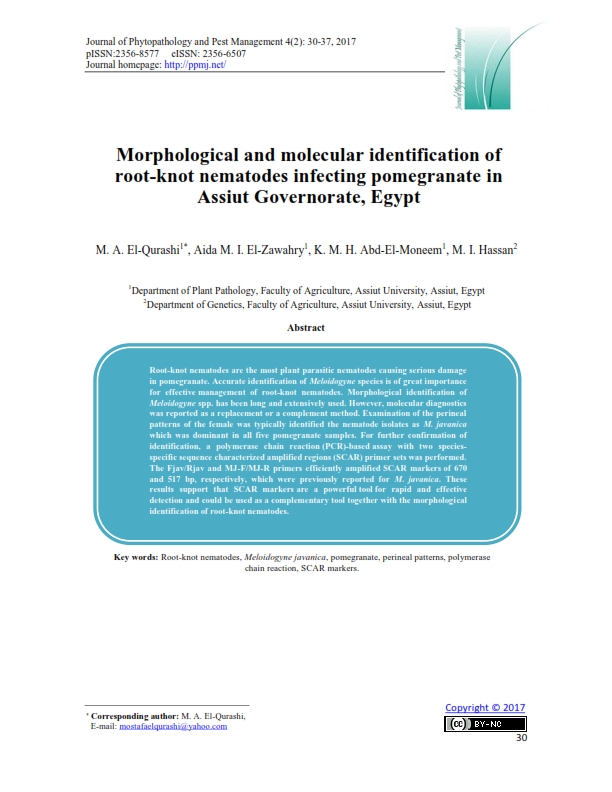Morphological and molecular identification of root-knot nematodes infecting pomegranate in Assiut Governorate, Egypt
Mots-clés :
Root-knot nematodes, Meloidogyne javanica, pomegranate, perineal patterns, polymerase chain reaction and SCAR markers.Résumé
Root-knot nematodes are the most plant parasitic nematodes causing serious damage in pomegranate. Accurate identification of Meloidogyne species is of great importance for effective management of root-knot nematodes. Morphological identification of Meloidogyne spp. has been long and extensively used. However, molecular diagnostics was reported as a replacement or a complement method. Examination of the perineal patterns of the female was typically identified the nematode isolates as M. javanica which was dominant in all five pomegranate samples. For further confirmation of identification, a polymerase chain reaction (PCR)-based assay with two species-specific sequence characterized amplified regions (SCAR) primer sets was performed. The Fjav/Rjav and MJ-F/MJ-R primers efficiently amplified SCAR markers of 670 and 517 bp, respectively, which were previously reported for M. javanica. These results support that SCAR markers are a powerful tool for rapid and effective detection and could be used as a complementary tool together with the morphological identification of root-knot nematodes.
Métriques

Téléchargements
Publiée
Comment citer
Numéro
Rubrique
Licence
Authors who publish with Journal of Phytopathology and Disease Management agree to the following terms:
- Authors retain copyright and grant the journal right of first publication with the work simultaneously licensed under a Creative Commons Attribution License that allows others to share the work with an acknowledgement of the work's authorship and initial publication in this journal.
- Authors retain copyright and grant the journal right of first publication with the work simultaneously licensed under the Creative Commons Attribution-Non Commercial License (CC BY-NC). This allows others to share the work with an acknowledgement of the work's authorship and initial publication in this journal.
- Archives of Agricultural Sciences Journal is an Open Access Journal, and articles published are distributed under the terms of the Creative Commons Attribution-Non Commercial License (CC BY-NC). Readers may copy, distribute, and display the work for non commercial purposes with the proper citation of the original work. However, the journal retains the right to exploit subsidiary rights on behalf of the authors.
- Authors are able to enter into separate, additional contractural arrangements for the non-exclusive distribution of the journal's published version of the work (e.g. post it to an institutional repository or publish it in a book), with an acknowledgement of its initial publication in this journal.
- Authors are permitted and encouraged to post their work online (e.g., in institutional repositories or on their website) prior to and during the submission process with full disclosure to the journal, as it can lead to productive exchanges, as well as earlier and greater citation of published work. Following publication in Archives of Agricultural Sciences Journal, the author should update the repository, and include a citation and link to the published work.
Click here for more information on Licensing policy
.png)




